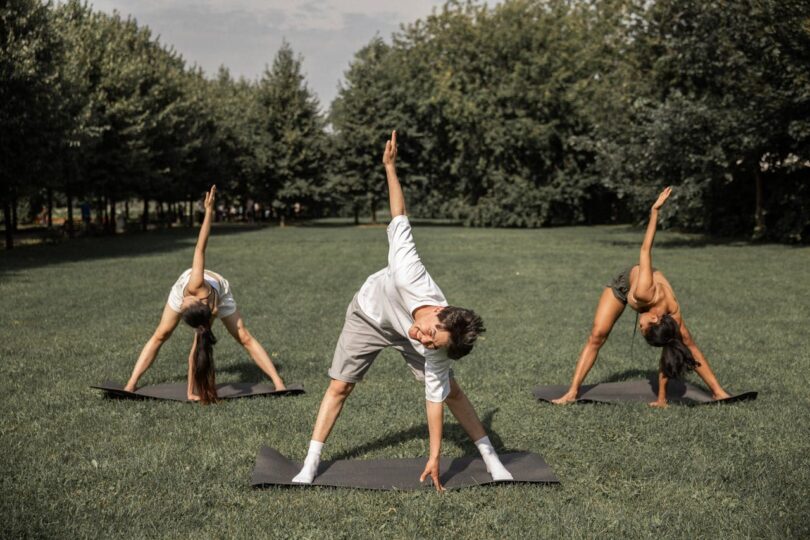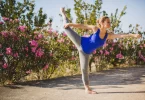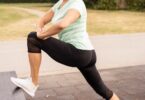Starting yoga can feel like a big step, especially if you’re new to it. But don’t worry. Finding beginner yoga classes near you is easier than you think. Whether you’re looking to improve your flexibility, reduce stress, or just try something new, there’s a class out there that’s perfect for you. This article will guide you through everything you need to know, from understanding the different types of yoga classes to finding the right studio and preparing for your first session.
Table of Contents
What is Beginner Yoga?
Beginner yoga is designed to introduce you to the basics of yoga practice. It’s perfect for those who have never tried yoga before or those who have taken a long break from it. These classes focus on fundamental poses, breathing techniques, and the foundational principles of yoga.
Importance of Starting Yoga
Yoga offers numerous benefits that go beyond just physical fitness. It helps improve your mental well-being, enhances your flexibility, and can significantly reduce stress levels. Starting yoga can be a transformative journey, bringing balance to both your body and mind.
Finding Beginner Yoga Classes Near Me
Searching for beginner yoga classes near me can yield a plethora of options. However, it’s essential to choose the right one that fits your schedule, comfort level, and personal goals. Here’s a detailed guide to help you find the best beginner yoga classes around.
Types of Beginner Yoga Classes
Hatha Yoga
Hatha Yoga is a gentle introduction to the most basic yoga postures. It’s ideal for beginners because of its slower pace and easier movements. You’ll focus on basic poses and proper alignment.
Vinyasa Yoga
Vinyasa Yoga involves a series of poses that flow smoothly into one another. It’s a bit more dynamic than Hatha and can be a good option if you prefer a more active practice.
Restorative Yoga
Restorative Yoga is all about relaxation and rejuvenation. It involves fewer poses, held for longer periods, and lots of props to support your body. This type of yoga is excellent for stress relief and calming the mind.
Yin Yoga
Yin Yoga targets the deeper connective tissues and is slower-paced, with poses held for longer periods. It’s great for improving flexibility and promoting joint health.
Benefits of Beginner Yoga
Physical Benefits
Yoga improves flexibility, strengthens muscles, enhances balance, and boosts cardiovascular health. It’s a low-impact exercise that’s accessible to almost everyone.
Mental Benefits
Yoga also offers mental health benefits. It can help reduce anxiety, improve concentration, and foster a sense of calm and well-being. Regular practice can lead to better stress management and overall mental clarity.
What to Expect in Your First Class
Your first yoga class can be a mix of excitement and nervousness. But don’t fret! Most beginner classes are designed to be welcoming and easy to follow. You’ll start with simple poses and gradually build up to more challenging ones. Remember to listen to your body and don’t push yourself too hard.
Finding the Right Yoga Studio
Looking for the right yoga studio can be a bit daunting, but it’s an important step to starting your yoga journey on the right foot. Here are some tips to help you find the perfect place for your beginner yoga classes.
Researching Local Yoga Studios
Start by researching yoga studios in your area. You can do this by searching online, asking friends and family for recommendations, or even checking out community boards. Look for studios that have good reviews and cater to beginners.
- Online Reviews: Websites like Yelp and Google Maps are great resources for finding yoga studios with good reputations. Pay attention to what people say about the instructors, the class environment, and the overall experience.
- Word of Mouth: Sometimes, the best recommendations come from people you know and trust. Ask friends, family, or colleagues if they know of any good yoga studios nearby.
Factors to Consider
When choosing a yoga studio, there are several factors to keep in mind to make sure you pick the right one for your needs.
- Location: Choose a studio that’s conveniently located. It should be easy to get to, whether you’re coming from home, work, or school. This makes it more likely you’ll stick with your practice.
- Class Schedule: Look for studios that offer classes that fit your schedule at times. Some studios have early morning, lunchtime, or evening classes, so you should be able to find a time that works for you.
- Pricing: Yoga classes can vary widely in price. Some studios offer drop-in rates, class packages, or monthly memberships. Consider your budget and find a studio that offers affordable options without compromising on quality.
Visiting the Studio
Before committing to a studio, it’s a good idea to visit in person. This gives you a chance to get a feel for the place and see if it’s a good fit for you.
- Class Observation: If possible, observe a class to see how the instructor interacts with students and how the class is conducted. This can give you a good sense of whether the studio’s teaching style matches what you’re looking for.
- Facilities: Check out the studio’s facilities. Make sure they are clean and well-maintained. Look for amenities like changing rooms, showers, and a comfortable waiting area.
Visiting the studio can also give you the opportunity to meet the staff and ask any questions you might have. Don’t hesitate to discuss any concerns or specific needs you have with the instructor or studio manager.
Preparing for Your First Class
Getting ready for your first yoga class can be both exciting and a little nerve-wracking. Here’s how to make sure you’re prepared and confident before stepping into the studio.
What to Wear
Choosing the right outfit can make a big difference in your comfort during class. Here are some tips:
- Comfortable Clothing: Wear clothes that allow you to move freely. Stretchy materials like leggings, yoga pants, and fitted tops are ideal. Avoid baggy clothes, as they can get in the way of your movements.
- Layers: Depending on the studio’s temperature, you might want to dress in layers. A light jacket or sweater can be useful for the beginning of class when you’re warming up or at the end during relaxation.
- Proper Footwear: Most yoga classes are done barefoot to help with grip and balance. However, some people prefer yoga socks that have grips on the bottom for extra traction.
What to Bring
Having the right gear can help you feel more prepared and at ease during your first class. Here’s a checklist:
- Yoga Mat: Many studios provide mats, but bringing your own can be more hygienic and comfortable. If you don’t have one yet, check if the studio offers rentals.
- Water Bottle: Staying hydrated is important, especially if you’re new to yoga and not used to the heat and physical exertion.
- Towel: A small towel can be handy to wipe away sweat during class, especially if you’re attending a more intense session like Vinyasa or hot yoga.
- Yoga Props: Some classes may require props like blocks, straps, or blankets. Studios usually provide these, but it doesn’t hurt to check ahead of time.
Tips for a Successful First-Class
To make the most of your first yoga class, keep these tips in mind:
- Arrive Early: Getting to the studio at least 10-15 minutes before class starts gives you time to check in, settle in, and get acquainted with the space.
- Introduce Yourself: Let the instructor know you’re new. They can provide additional guidance and support throughout the class.
- Listen to Your Body: Yoga is all about finding what feels good for you. Don’t push yourself too hard, and take breaks when needed. If a pose doesn’t feel right, modify it or ask the instructor for alternatives.
- Stay Open-Minded: Your first class is a learning experience. You might not get everything perfect, and that’s okay. The goal is to enjoy the process and improve over time.
Beginner Yoga Practices
Starting yoga involves learning some basic practices that lay the foundation for a fruitful journey. Here are essential yoga practices for beginners, including poses, breathing techniques, and meditation.
Basic Yoga Poses for Beginners
Learning a few fundamental poses will help you feel more comfortable and confident in your practice. Here are three essential poses to get you started:
Mountain Pose (Tadasana)
Mountain Pose is a simple yet powerful pose that forms the base for many other poses.
- Stand tall with feet together.
- Engage your thighs and pull your belly in.
- Relax your shoulders and extend your arms alongside your body.
- Breathe deeply and focus on grounding your feet on the floor.
Downward Dog (Adho Mukha Svanasana)
Downward Dog is a staple in many yoga classes, offering a full-body stretch.
- Start on your hands and knees with your wrists under your shoulders and knees under your hips.
- Lift your hips up and back, straightening your legs as much as possible.
- Press your hands firmly into the mat and keep your head between your arms.
- Hold for a few breaths and then release back to your starting position.
Child’s Pose (Balasana)
Child’s Pose is a resting pose that helps you relax and stretch your back.
- Kneel on the floor and sit back on your heels.
- Extend your arms forward and lower your forehead to the mat.
- Breathe deeply and let your body relax.
- Stay in this pose for as long as you need to feel rested.
Breathing Techniques
Proper breathing is a core aspect of yoga, helping you stay focused and calm.
Ujjayi Breath
Ujjayi Breath, also known as “victorious breath,” involves breathing in and out through your nose while constricting the back of your throat.
- Inhale deeply through your nose.
- Exhale slowly, making a soft hissing sound.
- Keep your breath steady and even, using this technique throughout your practice.
Meditation Practices
Meditation helps you develop mindfulness and reduce stress.
Basic Meditation
Starting with simple meditation practices can set a strong foundation.
- Find a quiet place to sit comfortably.
- Close your eyes and take a few deep breaths.
- Focus on your breath and let go of any distractions.
- If your mind wanders, gently bring it back to your breath.
These beginner yoga practices will help you get started on the right foot. Remember to practice regularly and listen to your body.
Staying Motivated
Maintaining motivation for your yoga practice can sometimes be challenging, but there are several strategies to help keep your enthusiasm alive. Here’s how to stay committed to your yoga journey.
Setting Realistic Goals
Having clear and achievable goals can keep you focused and motivated.
- Start Small: Begin with simple, attainable goals like attending a certain number of classes per week or mastering a specific pose.
- Track Progress: Keep a journal or use an app to monitor your progress. Note any improvements in your flexibility, strength, or mental clarity.
- Celebrate Milestones: Acknowledge your achievements, no matter how small. Reward yourself when you reach a goal, whether it’s with a new yoga mat or a relaxing day off.
Joining a Yoga Community
Being part of a community can provide support and encouragement.
- Attend Group Classes: Participating in group classes can help you feel connected and motivated. The energy of the group and the guidance of the instructor can be very inspiring.
- Online Communities: If attending physical classes isn’t feasible, join online yoga communities. Platforms like Instagram, Facebook, and dedicated yoga forums can connect you with like-minded individuals.
- Yoga Workshops and Retreats: Occasionally, join workshops or retreats to deepen your practice and meet new people. These events can rejuvenate your passion for yoga.
Tracking Your Progress
Keeping an eye on your progress helps you stay motivated and see how far you’ve come.
- Regular Assessments: Periodically assess your physical and mental progress. Are you more flexible? Has your balance improved? Do you feel calmer and more focused?
- Visual Records: Take photos or videos of your practice over time. This can be a great way to visually track your progress and stay inspired.
- Feedback from Instructors: Regularly seek feedback from your yoga instructors. They can provide insights on your improvement and areas that need work.
Staying motivated is crucial for maintaining a consistent yoga practice. By setting realistic goals, joining a community, and tracking your progress, you’ll find it easier to stay committed and enjoy the benefits of yoga.
FAQs about Beginner Yoga Near Me
Which yoga is best for beginners?
Hatha Yoga is often recommended for beginners. It’s gentle and focuses on basic poses and proper alignment, making it a great starting point for those new to yoga. Vinyasa Yoga is another good option if you prefer a more dynamic and flowing practice. Restorative Yoga is perfect if you’re looking for a relaxing experience, while Yin Yoga helps improve flexibility with longer-held poses.
Where should I start yoga for beginners?
Starting yoga for beginners is easy with the right resources. Local yoga studios often offer beginner classes tailored to those new to yoga. Additionally, many online platforms provide beginner yoga sessions that you can do at home. Websites like Yoga For Seniors offer detailed guides and classes specifically designed for beginners.
Where can I learn basic yoga?
You can learn basic yoga at local studios that offer beginner classes. Look for studios with good reviews and experienced instructors. Online resources are also a great way to start; platforms like YouTube and yoga websites provide a wide range of beginner tutorials. Check out free online yoga classes for convenient options to learn from home.
Can a beginner go to a yoga class?
Absolutely! Yoga classes are designed to cater to all levels, including beginners. Many studios offer classes specifically for beginners, ensuring a comfortable and supportive environment. If you’re new to yoga, let the instructor know before the class starts. They can provide modifications and extra guidance to help you through the session. Don’t be afraid to join a class and start your yoga journey with others.
Conclusion
Starting your yoga journey with beginner classes near you can be a rewarding experience. From understanding the basics of yoga to finding the right studio, preparing for your first class, and staying motivated, each step is essential to making yoga a regular part of your life.
Yoga offers numerous physical and mental benefits, from improved flexibility and strength to reduced stress and increased mindfulness. Remember, the key is to take it one step at a time and enjoy the process. Whether you join a local studio, practice at home, or connect with an online community, consistency is what matters most.
Your journey might have its ups and downs, but with patience and dedication, you’ll find yourself reaping the rewards of this ancient practice. Embrace the experience, listen to your body, and keep an open mind.
So, roll out your mat, take a deep breath, and start your yoga adventure today. The benefits you’ll gain are well worth the effort, and you’ll find yourself becoming stronger, calmer, and more centered with each practice. Happy practicing!







